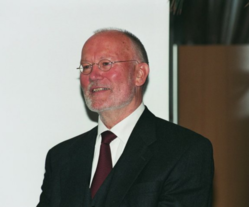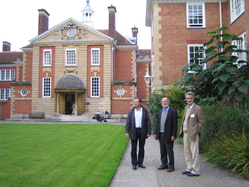
Hennie Kelder at his retirement gathering on 7 March 2008

Hennie Kelder (center) with Claus Zehner (left) and Bruno Carli (right)
at the ESA Advanced Atmospheric Training School in Oxford, Sept 2008
[ Download
text as PDF ]
|
|
After years of declining health, Prof. Dr. Hennie Kelder passed away on 3
July 2025. Hennie was head of the Atmospheric Composition department at KNMI
until his retirement in 2008. He was the driving force behind the major
Dutch role in satellite research of the ozone layer. When the ozone hole
over Antarctica was discovered in 1985, Hennie, who was working as a
researcher at KNMI at the time, recognized that the Netherlands possessed
the necessary expertise-both in measuring the ozone layer using satellite
instruments and in understanding it through modelling.
In the early 1990s, Hennie ensured that KNMI became involved in the
development of European satellite instruments GOME and SCIAMACHY. He seized
the opportunity to supply a satellite instrument built by Dutch industry to
NASA: the OMI (Ozone Monitoring Instrument). OMI was launched in 2004 and is
still operational. Hennie also advocated for TROPOMI, the improved successor
to OMI and SCIAMACHY. Launched in 2017, TROPOMI delivers the most accurate
measurements of global air pollution. Hennie had the vision to measure and
better understand the ozone layer, air pollution, and greenhouse gases from
space.
Originally a theoretical atmospheric scientist, Hennie strongly believed in
combining observations with modelling. He understood that, in addition to
satellite data, ground-based measurements were also essential. The first
ozone sounding balloon was launched in De Bilt in 1992, and in Paramaribo
(Suriname) in 1999. These measurements and climate-relevant data series
continue to this day.
Hennie was a charismatic individual with a deep understanding of people.
With his humor and warmth, he was able to inspire and motivate his
colleagues. He had a keen intuition for which areas of physics mattered and
which individuals were suited to tackle them. Regardless of experience, he
placed trust and responsibility in his staff. When he entered your office,
he would say, "So, work is being done here!" -- usually followed by a
request that added another task to your plate. And we -- mostly -- took
on these tasks with pleasure.
Hennie was a true networker, with contacts throughout the Netherlands and
Europe. He travelled extensively for scientific collaborations and new
projects, and was already visiting China in the early stages of its
scientific engagement. Hennie was full of ideas and was successful in
acquiring national and European projects. He also advised ESA on new
satellite missions.
Hennie had strong ties with the Ministry of Infrastructure and Water
Management. He was able to convince policymakers in The Hague how important
satellite measurements are for environmental monitoring and in the interest
for the Netherlands to participate in (inter)national satellite projects. He
brought together science, environmental policy, and the space industry in
the Netherlands.
The small ozone group at KNMI which Hennie started in the early 1990s grew
steadily through external funding. Hennie laid the foundation for what is
now KNMI's R&D Satellite Observations department, with more than 60
members.
In 2000, Hennie was appointed part-time professor at Eindhoven University of
Technology. He supervised many PhD students in the field of atmospheric
chemistry and dynamics.
Hennie retired in 2008. Sadly, the years that followed were difficult due to
the loss of his wife Ella and his son Paul, and his own declining health
after an accident.
We remember Hennie with gratitude and affection, and extend our heartfelt
condolences to his family.
De Bilt, 8 July 2025
R&D Satellite Observations Department, KNMI
|
|